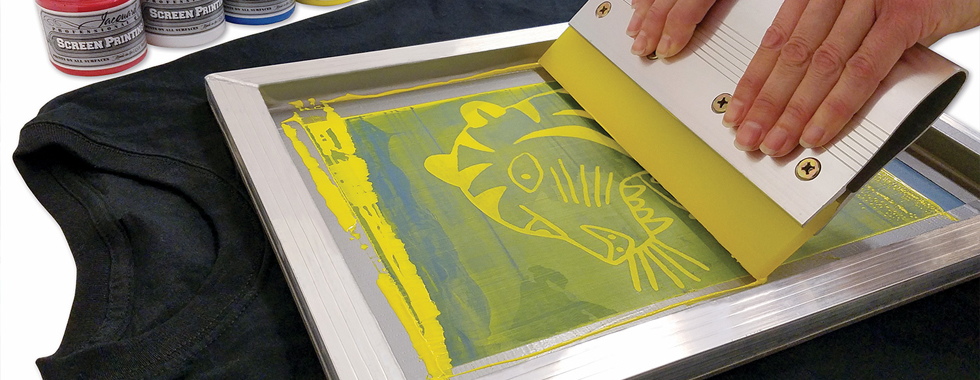The Necessary Guide to Recognizing Screen Printing and Its Versatile Utilizes
Screen printing has an abundant background that dates back to old times, developing right into an innovative technique made use of across numerous markets today. This overview checks out the complexities of the screen printing procedure, detailing its applications in style, home, and advertising and marketing design - 10:9 Design contact. Comprehending these principles can open up innovative capacity for both business and artistic tasks. The following sections will expose essential suggestions and strategies to boost one's screen printing endeavors
The History of Screen Printing
Screen printing has origins that trace back centuries, its development shows the artistic and technical advancements of numerous societies. Coming from old China, the technique was at first made use of for enhancing fabrics and later infect Japan, where it became essential to Ukiyo-e woodblock printing. The technique moved to Europe in the 18th century, where it got appeal amongst artisans and commercial printers. The innovation of picture emulsion in the 20th century revolutionized screen printing, allowing for even more complex styles and greater efficiency. Musicians like Andy Warhol additionally drove its popularity, using the tool to produce renowned works that combined commercialism and great art. By the late 20th century, screen printing had established itself as a functional method, employed in vogue, advertising and marketing, and great art. Today, it remains to develop, integrating electronic innovation and expanding its applications across numerous sectors.
The Screen Printing Process Explained
Screen printing transforms imaginative visions right into concrete layouts through a series of precise actions. An image is produced and after that transferred onto a screen, commonly made of fine mesh textile stretched over a framework. A light-sensitive emulsion is put on the screen, which is exposed to light, solidifying in areas not covered by the picture. After rinsing the unhardened emulsion, a pattern is created.
Next, the screen is positioned over the substrate, whether it be textile, paper, or an additional product. Ink is then pressed with the open areas of the pattern using a squeegee, depositing the style onto the substratum listed below. This procedure can be repeated for multiple shades, needing separate displays for each and every hue. Ultimately, the printed product is cured utilizing warmth to guarantee the ink adheres properly, resulting in a long lasting, lively design prepared for use.
Types of Screen Printing Techniques

Additionally, specialty methods, such as discharge screen printing, eliminate color from the textile to develop softer prints, while aluminum foil screen printing uses metallic foil to attain a shiny coating (10:9 Design near me). Each strategy supplies distinct qualities, catering to various innovative demands and production ranges, inevitably increasing the opportunities within the screen printing domain name
Applications of Screen Printing in Numerous Industries

In addition, the signs and marketing markets utilize screen printing for producing attractive displays and banners. This technique permits strong colors and intricate styles that record interest. In electronics, screen printing is employed for using conductive inks to circuit card, important for component links. Moreover, the home design industry welcomes screen printing to produce distinct designs on textiles and wall art. In general, screen printing offers as a vital tool throughout diverse fields, improving products with personalized and visually enticing graphics.
Tips for Effective Screen Printing Projects
While carrying out a screen printing job, careful interest to information can substantially improve the final end result. Picking top notch materials is necessary; this includes the screen, inks, and substrates. Utilizing proper mesh matters can influence ink deposition and detail resolution. more helpful hints Preparation is just as important; comprehensive cleansing of screens and appropriate direct exposure times assure crisp prints.
Next off, precise registration is critical for multi-color prints. Utilizing positioning devices can assist accomplish precise layering. Additionally, testing prints on scrap materials before manufacturing aids identify possible issues without useful content throwing away resources.

Frequently Asked Concerns
What Materials Are Finest for Screen Printing on Textile?
Cotton and polyester blends are ideal for screen printing on fabric as a result of their toughness and ink absorption. In addition, specialized textiles like silk or canvas can create special appearances and surfaces, boosting the overall style top quality.
Exactly how Do I Clean and Maintain Screen Printing Equipment?
To keep and cleanse screen printing tools, one must frequently clean screens with suitable solvents, evaluate mops for wear, lubricate moving parts, and shop all products in a dry, dust-free setting to extend their life-span.
What Are the Ecological Impacts of Screen Printing?
Screen printing can have significant environmental influences, including chemical waste from solvents and inks, water usage throughout cleaning processes, and power consumption. Green materials and sustainable methods are vital for decreasing these adverse effects.
Can Screen Printing Be Done in the house Efficiently?
Screen printing can be efficiently done at home with the right materials and strategies. Hobbyists can develop top quality prints, though success depends on their skill degree, equipment, and understanding of the process entailed.
What Are the Costs Linked With Starting a Display Printing Business?

Beginning a screen printing organization entails prices for tools, products, and work area. Preliminary costs typically range from a couple of hundred to numerous thousand dollars, depending on check the scale, quality of equipment, and desired manufacturing capability.
Screen printing has a rich background that dates back to old times, evolving right into a sophisticated method used throughout numerous sectors today. One more strategy, rotary screen printing, utilizes cylindrical screens, facilitating continual printing on material rolls, thereby improving performance for massive manufacturings. Additionally, specialty methods, such as discharge screen printing, eliminate dye from the textile to produce softer prints, while foil screen printing applies metal aluminum foil to attain a glossy finish. In the style sector, screen printing is widely used to create dynamic styles on apparel, making it possible for brands to showcase their unique styles. Cotton and polyester blends are optimal for screen printing on fabric due to their durability and ink absorption.